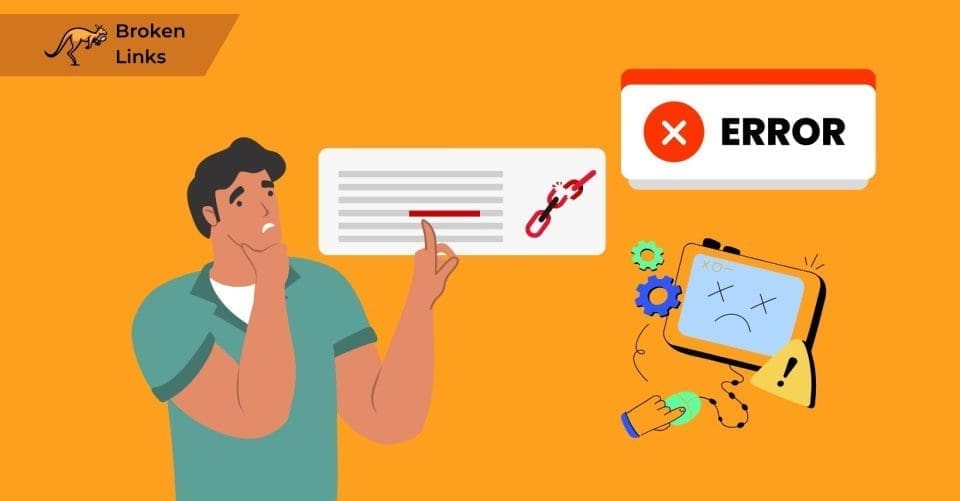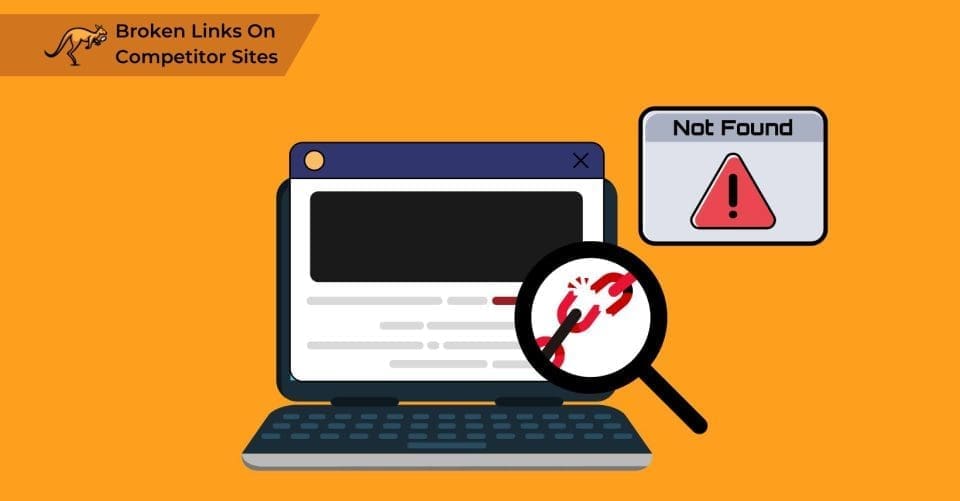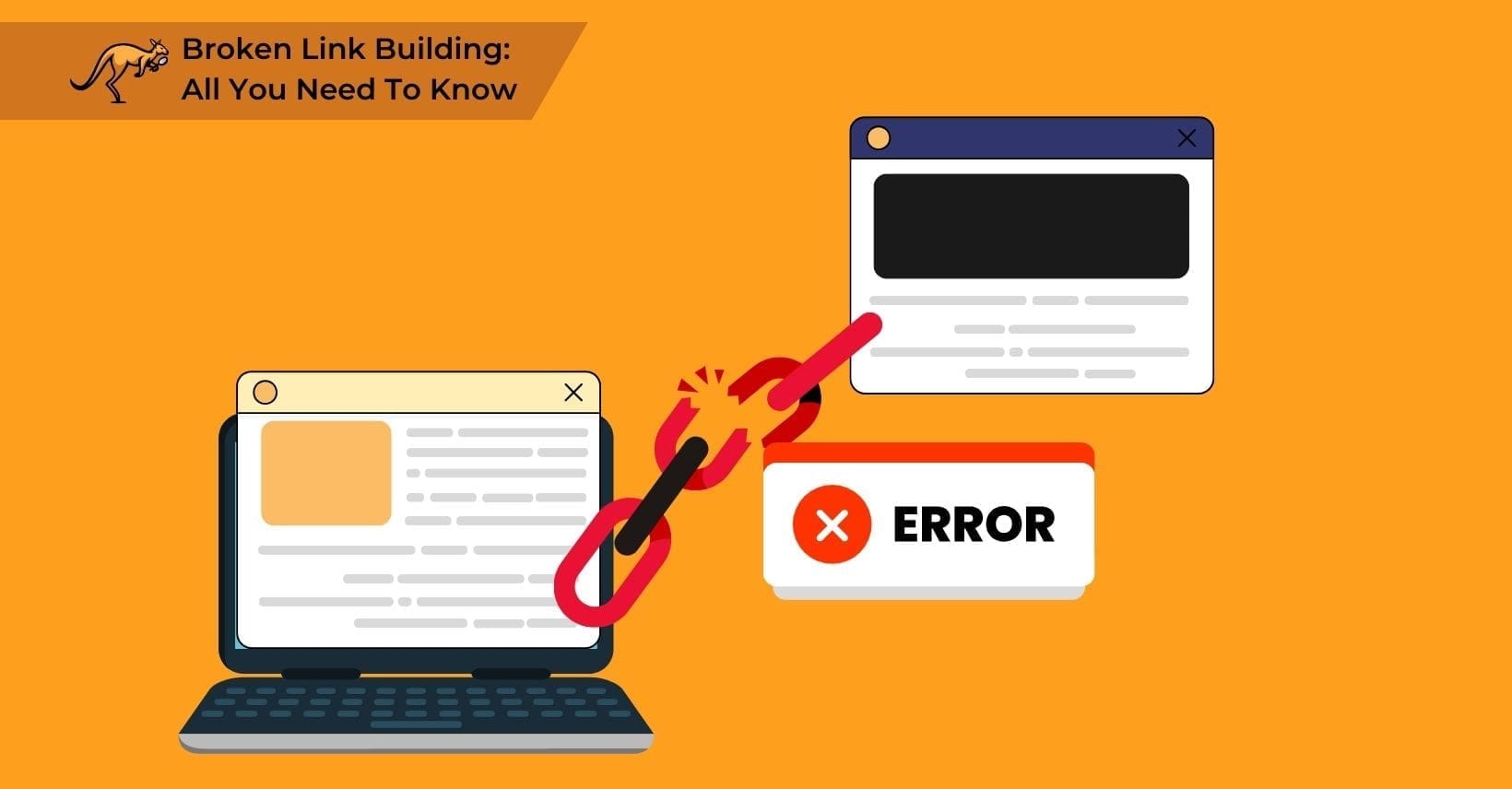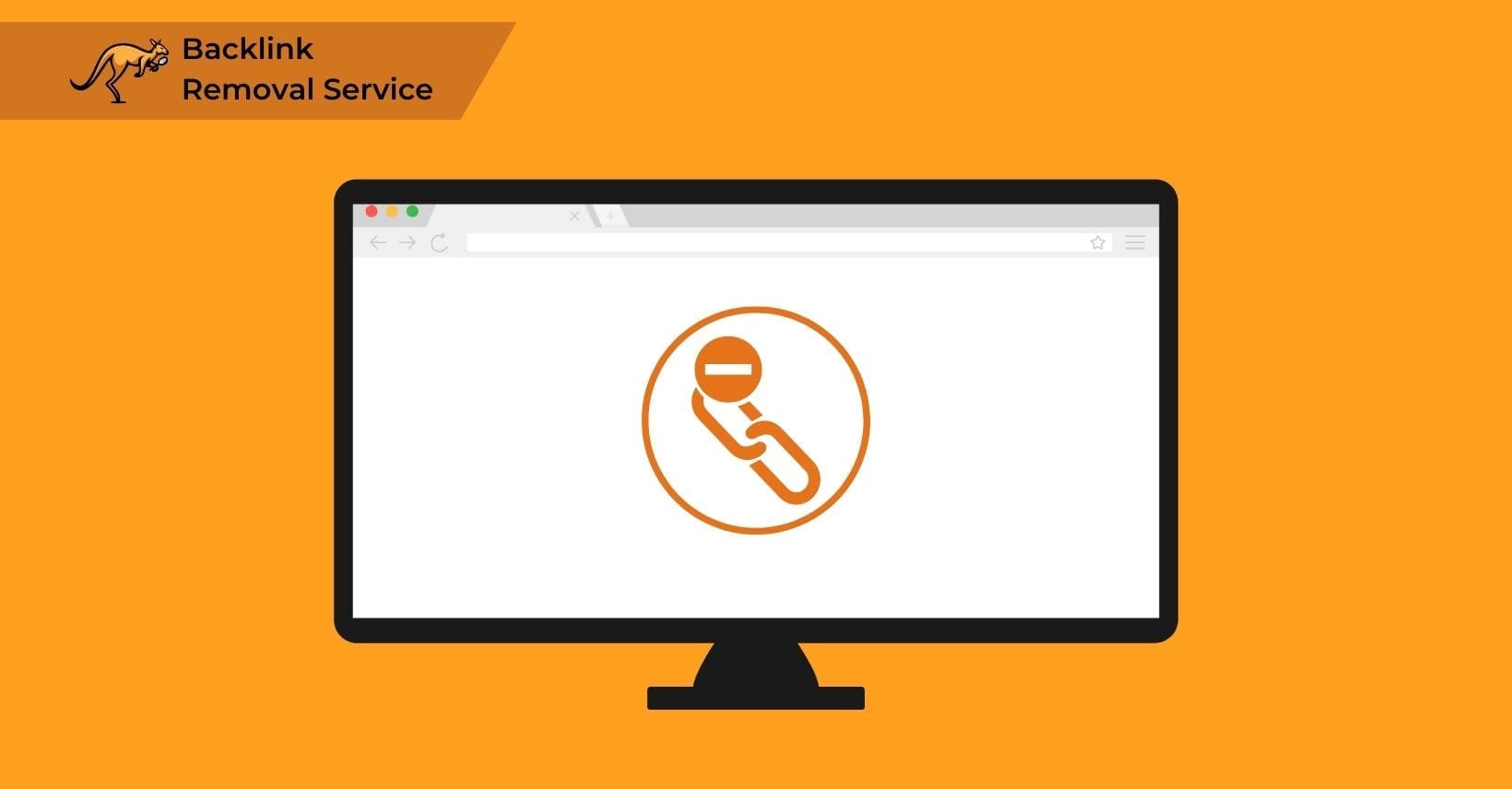Broken links, which are backlinks pointing to an outdated or incorrect URL, are a constant problem in SEO. They are also the source of many broken link-building opportunities. For SEO experts, broken link building can be an effective way to gather extra backlinks. However, there are better strategies than broken link building. Between creating relevant content and securing broken backlinks as your own, building links using this method can be challenging. You must identify and take advantage of broken links to leverage broken link building for your business. Knowing the details about these broken links can make a significant difference.
What are Broken Links?

A broken link is a link that no longer points to a valid URL. This could be due to deleted blog posts, web pages that are no longer hosted, or entire websites that no longer exist. Simply put, a broken link does not lead to anything useful. The URL may direct to a broken page or a generic error page on a still-existing site.
These broken links offer a unique opportunity to enhance SEO.
What is broken link building?
Broken link building is a strategic SEO technique where marketers identify non-functioning links on websites, create replacement content, and request webmasters to redirect those broken links to their own relevant pages, which generates valuable backlinks without requiring new content creation from the site owner.
Regardless, broken links have a purpose, and broken link building involves finding and using these links for your site and content. Site owners dislike broken links as they can make their site look bad and frustrate visitors. By engaging in broken link building, you can negotiate with site owners to redirect broken links to your site, gaining their value while helping site owners fix their broken links without major content changes.
The benefits for site owners in agreeing to this practice are quite compelling.
Why do site owners agree to broken link building?
The key factor that makes broken link-building effective is preserving the original content. In a broken link-building campaign, you aim to find broken pages relevant to your site and content, as these are the easiest links to claim. By providing a website manager with similar content that fits the same niche, you offer a solution to fix their dead link with relevant websites and content. Website owners prefer not to change their content frequently, especially if it has gained significant attention and links from other sites. By offering them a replacement resource, you save them the effort of altering their content to remove the dead link entirely.
This approach leads us to consider the benefits of broken link building and how it enhances your site’s authority and traffic.
How does broken link-building help?
Broken link building works for SEO by converting dead backlinks into active ones pointing to your website, which search engines interpret as legitimate backlinks that pass authority and trust to your domain, thereby improving your search rankings and visibility.
Broken link building provides multiple benefits including acquiring high-quality external links that strengthen your backlink profile, gaining an edge over competitors by inheriting authority from previously established pages, and building relationships with website owners by solving their broken link problems.. Turning dead links into active ones is like conventionally obtaining high-quality backlinks. You inherit some authority from the original page, boosting your SEO.
As with any strategy, it is important to assess its effectiveness and explore if other methods might be more impactful.
Does broken link building still work?
Many believe dead URL broken link building is ineffective, but most dead links still offer value. Search engines now treat broken link building like regular link building, holding it to the same standards. It’s not a shortcut to SEO success and won’t always work. Yet, effectively using broken links can boost your site’s SEO.
You must know how to handle broken link building to maximize these benefits.
How to handle broken link-building
Implementing a broken link building strategy requires following four systematic steps: identifying broken links on competitor websites or in your niche, finding topic-specific pages with broken links, discovering resource pages with outdated links, and locating working links that point to irrelevant content or repurposed domains.
- Find broken links from data about competitors’ websites or links in the same niche as your business.
- Find pages – based on a specific topic – that connect to many broken links or link to content that no longer exists.
- Find resource pages that are out-of-date or do not point to valid pages.
- Find a working link pointing back to irrelevant content or a new site that took over an old URL.
To find valuable links, look for those leading to incorrect or dead content. A website manager is more likely to replace a truly dead link than one that just redirects. This strategy helps boost your site’s authority and improve user experience. Identifying broken links can open new opportunities. Find broken links on competitor sites.
Find broken links on competitor sites

Use site and link explorer tools on your competitor’s URL to see all backlinks, including invalid ones. This helps you find dead pages, like outdated product URLs or deleted blog posts. Check competitor sites to estimate broken links. Then, use your link-building tools to filter and identify high-potential dead links. Once you know which broken pages and backlinks to target, contact the original sites and offer your resource pages as replacements. Relevancy and context are key. Targeting a broken link for a shared product is straightforward, but not for links specific to your competitor.
Keep in mind that finding the right topic can make all the difference.
Look for a broken page about a certain topic.
Link building involves topics and relevant keywords. Hunting down resource pages or dead links that align with your business is a great option. For example, targeting broken links related to technical writing is beneficial if your company offers that service. This approach boosts web traffic, enhances SEO, and increases the likelihood of getting the website owner to update the link.
Filtering backlinks effectively often requires tools like Ahrefs Site Explorer and Content Explorer, but always consider their relevance to your business. SEO focuses more on the quality of backlinks than the quantity. This strategy streamlines broken link-building by emphasizing relevant topics. Identifying broken pages that match your business needs helps promote your services or products effectively.
As you refine this process, watch valuable opportunities hidden in resource pages.
Look for dead links on resource pages.
Resource pages link to a range of resources on a site. These could be extra sections at the bottom of blog posts or separate pages, but they all connect to relevant content. These pages attract a lot of traffic and boost SEO, especially if they come from high-ranking sites. Linking to niche content makes the site relevant to the linked pages, creating great opportunities for broken link building. These pages often include several backlinks, some of which may be dead. To succeed in broken link building, your content must match or exceed the quality of the original dead links. Securing such a link can significantly enhance your site’s credibility.
Replacing Irrelevant Content
A dead link might not lead to a non-existent page but to a page that no longer has the expected content or belongs to the same site. This often occurs with sites hosted on certain services, where another owner may reuse a link if the original site vanishes. It can also happen if a blog post is removed or a site changes its content. These links don’t typically appear in broken link reports since the pages aren’t technically broken, but they’re still valuable for dead link building. Whether the URL’s content was deleted or replaced with another page, addressing these issues can earn extra links. Irrelevant content is something most sites avoid, making link building with irrelevant links straightforward—you just need to offer the website owner your replacement link.
Spotting these issues early can make the process smoother and more effective…
Vetting Broken Links
Vetting broken links for quality involves evaluating three critical factors: the original page’s search engine value, the relevancy of the linking page to your content, and the keywords used in the anchor text, which ensures you only pursue broken links that will genuinely benefit your SEO performance.. Identifying broken links that benefit your website or business is crucial. Careless dead link building can waste effort on links that don’t boost your SEO. Consider the specifics of what broken links offer. Building links incorrectly might only add to your content without real benefits.
To truly benefit, understanding the importance of each link’s quality is key…
Link Quality
Quality is key. A good link boosts your SEO and offers tangible benefits, like higher rankings for specific keywords. Backlink quality depends on several factors:
- The original page’s value to search engines
- The relevancy of the linking page
- The keywords used
Ideally, you want relevant links with accurate keywords from well-known and respected sites. A site with good SEO and strong search rankings will likely provide a beneficial link.
Bad quality links include spam, links from sites with weak link portfolios, or links with unrelated keywords. These can harm your SEO rather than help it. High-quality links provide more “link juice.” Choose good referring domains offering relevant keywords as your main source of links. Link quality is essentially desirability; the more desirable the backlinks, the higher their quality.
While link quality is vital, watching for issues that can negatively impact your site, such as broken links, is important.
Broken Link Types
To understand the original content’s context, it’s crucial to provide something of equal value; otherwise, the site’s owner might remove the link. There are two main link types: general and deep. General links point to a whole resource, like an entire store, while deep links focus on specific pages for particular reasons. General links might be easier to get from sites recommending similar resources. In contrast, deep links are more valuable due to their specificity. If your content closely matches the original, securing deep links becomes easier. Stray too far, and you risk losing the link.
Expanding your reach often involves producing additional material.
Creating More Content
Creating content for broken link building requires developing material that closely matches the original dead page’s context, tone, and goals, while including obvious linkable sections with relevant keywords and providing substantial value that makes website owners willing to replace their broken links with yours.. This process can be straightforward, but you must ensure the content’s context, tone, and goals align with what the link implies. Assumptions are necessary when the original content doesn’t exist as indexed pages. For instance, a resources page about accounting likely links to pages on self-accounting, tax form calculations, or third-party tools. Ensure your indexed pages align with these links, possibly using SEO tools to identify suitable keywords. To make this process smoother, you need to insert obvious linkable details.
Insert Obvious Linkable Details
You don’t need a backlink analysis tool or report to identify the crucial parts of your content. Just include some “bait” to make the page worth linking to. Building these sections is vital. Even if you add extra words to extend the content, focus on a section with relevant keywords and phrases to maximize the link benefits.
Remember, there’s no guaranteed way to get it perfect immediately. The advantage of hosting content on your site is that you can always make changes. A strong first impression allows for future tweaks.
Include Actual Value
A common error with content, including guest posts on other sites, is lacking substance. This becomes crucial when convincing a site owner to include your link. Expect rejection if the content doesn’t add value beyond mere space-filling. Payment might secure placement, but it heavily depends on the site owner’s standards and what they consider worthy of linking.
Improving acceptance rates can often hinge on your next steps in approaching this task effectively.
Outreach
Broken link building requires specialized tools such as Ahrefs Site Explorer and Check My Links, which scan websites to identify broken links and their referring domains, while Content Explorer helps find relevant topic opportunities and link explorer tools reveal competitors’ invalid backlinks. Conducting outreach for broken link building involves directly contacting domain owners with evidence of their broken links, offering your prepared replacement content as a solution, following up if necessary, and continuously searching for additional opportunities while refining your approach based on responses. Showing them the results from Check My Links can often be enough to convince them, especially if they can inspect the links themselves.
Show them the broken links and offer a replacement, sending a follow-up email if needed. Meanwhile, search for more opportunities using Check My Links and other tools. If they accept, great. If not, you haven’t wasted much time. If they’re open to the idea, refine your approach.
Sometimes, getting a little help can make this process even smoother.
How Link Building Agencies Help you with Broken Links?
Link-building agencies find and fix broken links, which can damage your website’s SEO. These experts use tools like Ahrefs Site Explorer and Check My Links to find broken links on your site and others that could link back to you. They identify broken links on high-authority domains and then reach out to the domain owners with quality content to replace them. This process helps recover lost link equity and strengthens your backlink profile. The agency’s skilled messages and follow-ups increase the chances of replacing broken links, saving you time. Their systematic monitoring ensures your website maintains strong SEO. For these reasons, considering a partner like Searcharoo for your link-building needs is smart.
Why Partner with Searcharoo for your Link Building needs?
Partnering with Searcharoo for link-building brings many benefits. Our strategic approach and proven SEO results set us apart. Our team of experts uses data-driven methods to find the best link-building chances for your niche. We build a strong backlink strategy that boosts your site’s authority and search rankings. Our high-quality links from authoritative sites offer long-term SEO benefits. Our transparent reporting keeps you updated on progress and impact. Choosing Searcharoo means tapping into our expertise, resources, and dedication to excellence, ensuring top search engine performance. Now, let’s explore how these strategies contribute to your overall success.
Closing Thoughts: Enhancing SEO with Link Building
A large part of this kind of link-building is based on common sense. Consider what your customers might put into the search bar and the keywords you would get the best results from targeting.
While highlighting broken links is useful, you need to know how to use them and find or prepare content that suits them.
Tools, like Check My Links, are great for breaking down a site’s link profile, but they can’t tell you the best kind of content to create or the keywords that will matter most for that specific link.
Think carefully about each decision you make, and do not overextend yourself. Going too far away from your business’s niche can make securing these links even harder.
Whatever you decide to target and whichever ways you push for more links, just remember that you can target countless broken links out there. Do not get hung up on a specific link, especially not when there are always others you might be able to acquire instead.





